Four years on from the original release of The Outer Worlds, the Spacer’s Choice Edition bundles up all of the game’s DLC and comprehensively overhauled visuals for a $10 upgrade fee – with the idea being to take advantage of PS5, Series X and S. Sadly, despite the depth of the changes on offer, the overall experience is flawed with frame-rates struggling to hit 60fps, plus a questionable shift in its art direction.
The experience on console – and PC – has been subject to a lot of negative feedback since its release, especially with regards to its performance. And this holds true as of the latest patch 1.1 on PS5 as well, sadly, where this iteration of the game still isn’t one we can recommend. Today then, between PS5, Series X and S we’ve looked at three major points of the Spacer’s Choice Edition: firstly, how the consoles differ in their visuals and frame-rates. Secondly: which modes offer the best experience – between performance and cinematic modes – and finally, how far the visual upgrades go compared to the base game.
Before we get into the revamped Spacer’s Choice Edition, it’s worth highlighting how the original Outer Worlds release runs on a current-gen console today. Thankfully, the original Outer Worlds – sans visual updates – is available on Game Pass on Xbox Series X, giving us a handy point of comparison.
For Series X users, the original version of the game runs on the One X code-path with soft back-compat enhancements to let it run uncapped at 60fps. (And in fact, the same is true for the PS4 edition running on a PS5 system.) On Series X, we get a dynamic 4K resolution this way, with drops to the mid-50s possible but a 60fps lock being achievable for the bulk of play. It’s a pretty reasonable option then, using the power of the current-gen machines to run the game at higher resolutions and frame-rates than would be possible on the last-gen hardware.
Switching over to the Spacer’s Choice Edition, also running on Series X, shows immediate benefits and drawbacks by comparison. Certainly the visuals are dramatically altered – but performance is degraded in the same breath, with the opening segment of the game now running at well below 60fps. This is the issue in a nutshell: rather than polishing up the sub-60fps dips of the original code, the priority is instead placed on further embelishing the visuals – resulting in a worse overall frame-rate. All of which is a devil’s bargain given the existing, original version runs well as-is on PS5 and Series X.
The focus for today’s coverage is squarely on the console editions, however, so let’s start on the upgrades. Spacer’s Choice runs on an updated Unreal Engine 4 build, with the intent to capitalise on PS5 and Xbox Series X’s horsepower by virtue of being a true, native app.
In the 30fps cinematic mode, the game provides a good first impression as you explore the landscape of the starting planet, Terra 2. Grass is more abundant, trees are redrawn and textures are reworked. We see ground textures and rocks broadly use higher resolution assets – and even geometry placement is altered across the scene. From the word go, it results in a more densely layered opening area. In others? It’s perhaps less of an objective improvement, and more of an artistic side-step.
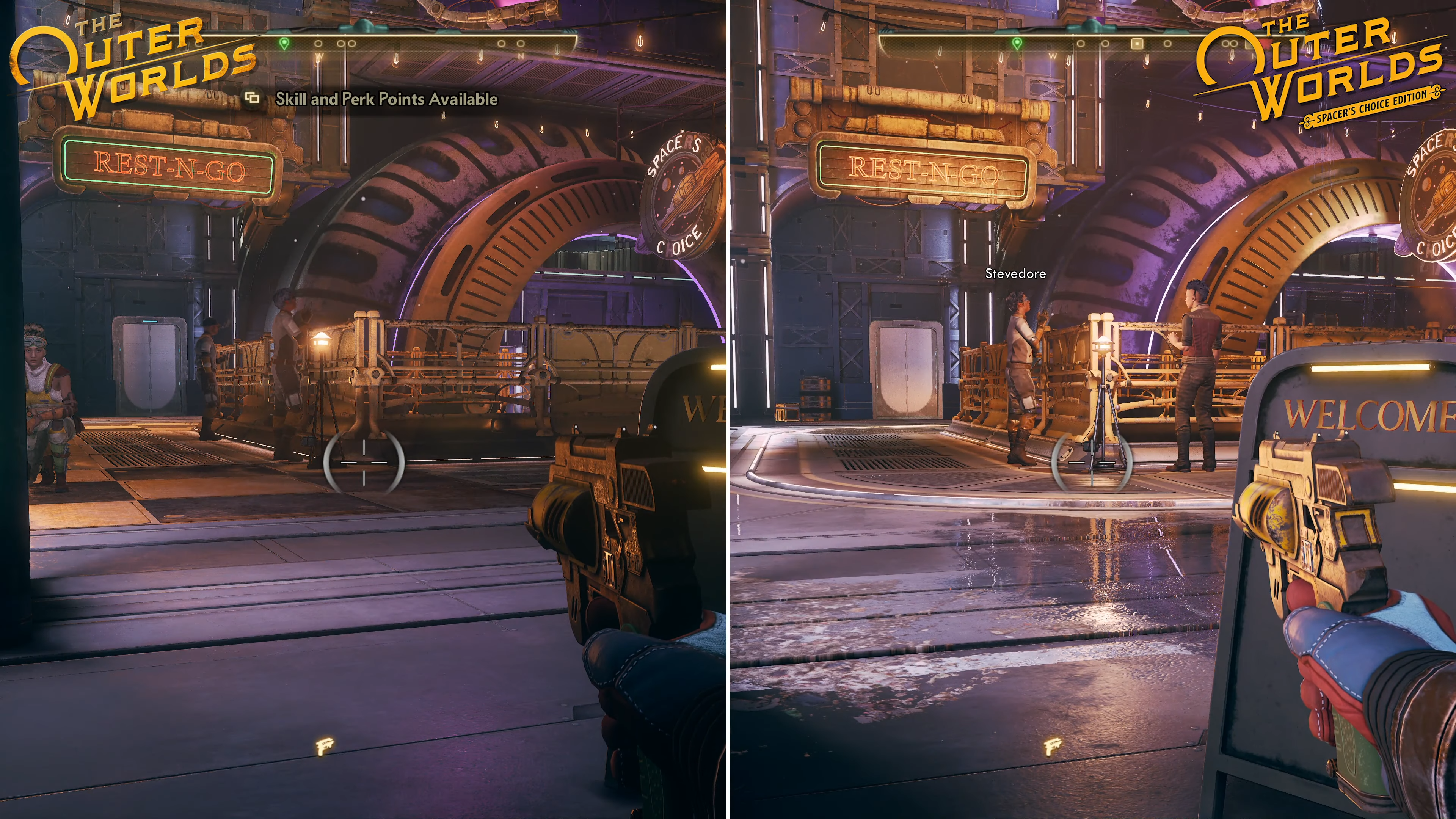
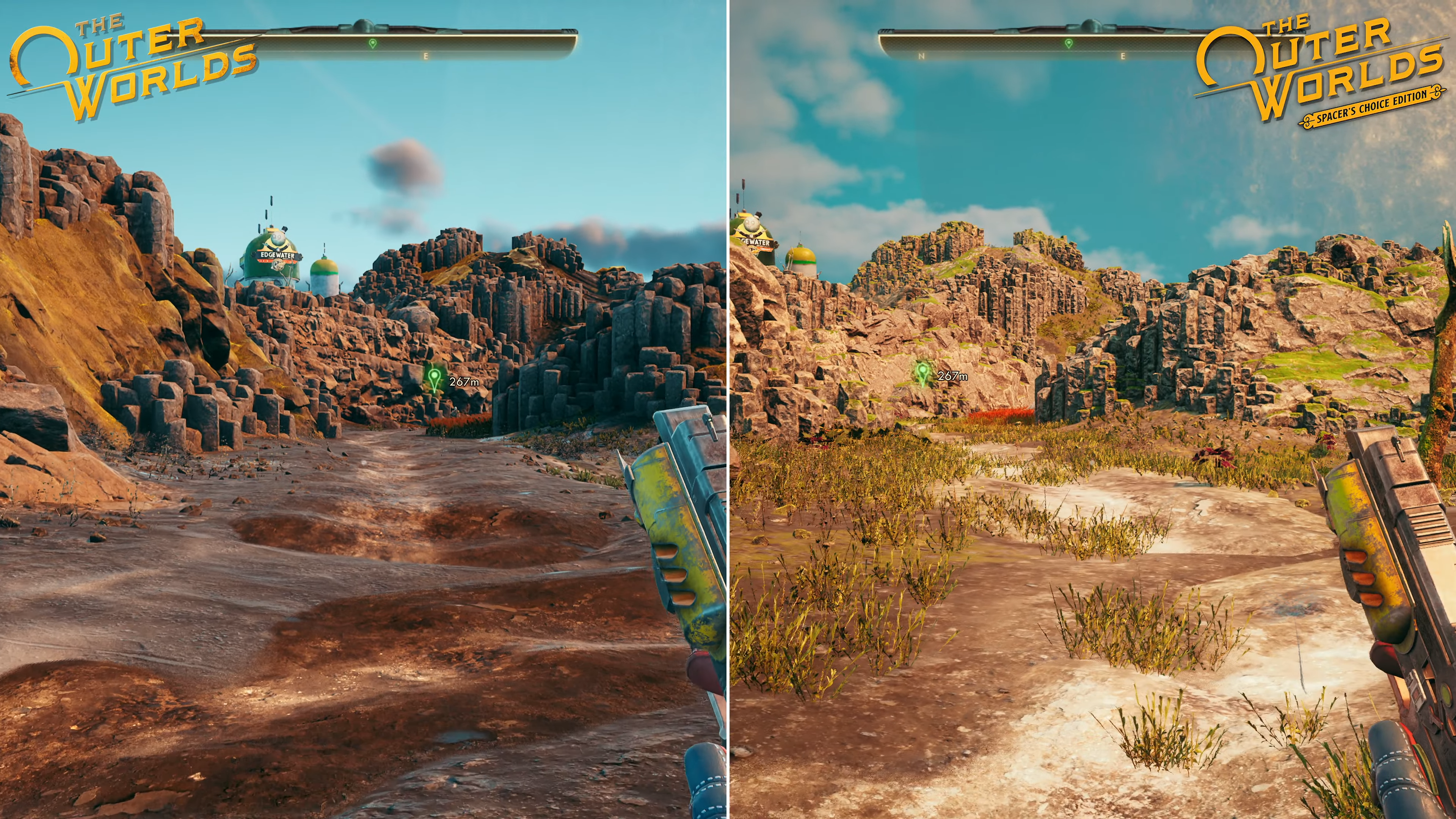
Keeping with the good news, major characters also have reworked models, with eyes that reflect light more realistically and higher-res skin shaders. Not all textures are radically changed, mind you, but certainly enough to hold up to closer scrutiny. Another obvious change is the addition of volumetric lighting to the world. The original release of The Outer Worlds already had bloom, lens flare and a light form of the god ray effect, but this new release allows light to fill an empty space. Interior areas now have a satisfying density to the air when populated with dust, mist, or steam. Overall, it’s a welcome upgrade for interior areas, from beautiful crepuscular rays leaking through apertures in the ceiling to the streaks of light around spaceship docking bays – it all sits very naturally.
Materials and lighting are radically overhauled at points, but it’s not a universal success. At times, the changes give towns a drastically different aesthetic, like Edgewater which takes on a deeper red hue due to the lower arc of the sun, with similar changes to later planets as well. The outskirts of Stellar Bay now deploy a heavy-handed approach to volumetrics, with rising dust and cyclones adding a certain weight to the air. It’s a huge artistic break from Obsidian’s original game, and for returning players it might take some adjusting to.
Beyond the visual upgrades and changes in art direction, some visual features are missing compared to the original release. For example, shadow draw is pruned back. On PS5, Series X and S, large objects – like the player’s ship – demand much closer proxomity before a shadow is drawn in below it. We also spotted missing dynamic shadows below characters and objects in some indoor scenes.

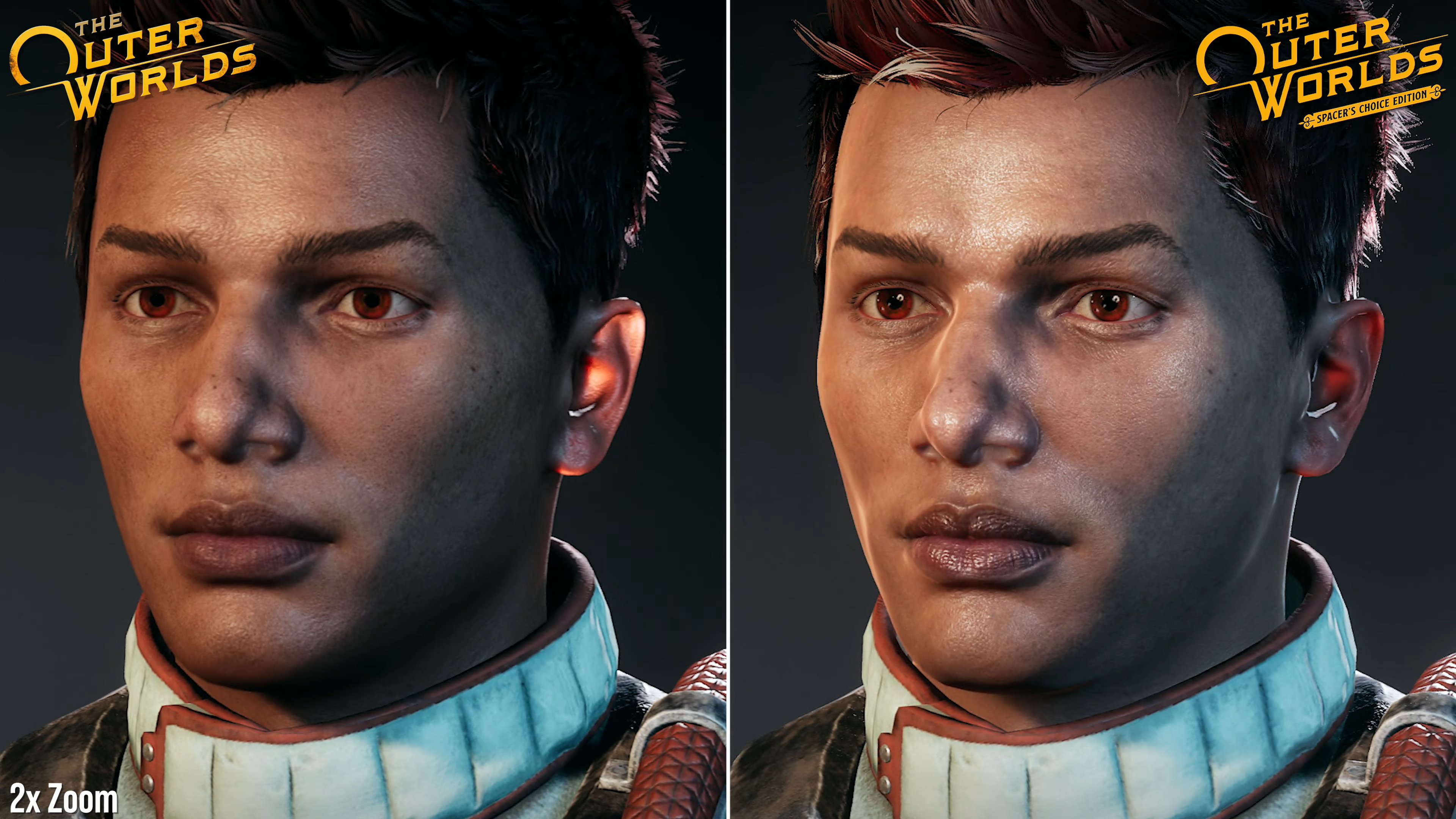
All of which brings us to those 30fps (cinematic) and 60fps (performance) modes, which work near identically on PS5, Series X and Series S. Both modes offer the same settings in terms of textures, volumetrics and shadows, but screen space reflections (SSR) are removed in performance mode and ambient occlusion (AO) runs at a lower resolution. The AO downgrade isn’t too noticeable, but the removal of SSR is disappointing given that this feature was possible at 60fps in the original game on current-gen hardware. Patch 1.1 also reduces grass density on PS5 in the performance mode – likely a push to boost frame-rates for this mode – and I expect we’ll see a similar change once the patch arrives on Xbox Series consoles as well.
It’s a very mixed turnout then. To get the best visual returns you’ll have to run in the cinematic 30fps mode, a clear drop coming from the 60fps of the older version. In terms of resoutions, both PS5 and Series X run at a dynamic 4K here, dropping to 2560×1440 at lowest – similar to the range we had in the original game on Series X. Series S inevitably runs at a lower internal resolution, coming in at a steady 972p in the bulk of our tests. Grass density and ambient occlusion are also set lower on the 4TF console, which can cause a pixellated shimmer on grassy elements. In performance mode, PS5 and Series X also still run at a dynamic 4K – just with a lower average resolution given that the 60fps target is harder to hit. And oddly enough, Series S sticks to its native 972p presentation in performance mode too.
In terms of performance, neither the cinematic or performance modes are easy to recommend on any console right now. The 30fps cap in cinematic mode comes with frame-pacing issues on every platform with fluctuating frame-times, and the possibility of hitches beyond this. This state of affairs is particularly frustrating when even the PS4 Pro and Xbox One X delivered a clean 30fps cap on the original version of the game. In addition to the frame-pacing problems, there are also drops below 30fps, especially on PS5. Even with patch 1.1 installed, we can see the frame-rate momentarily drop to 15fps in battle, which makes aiming difficult and just feels jarring.
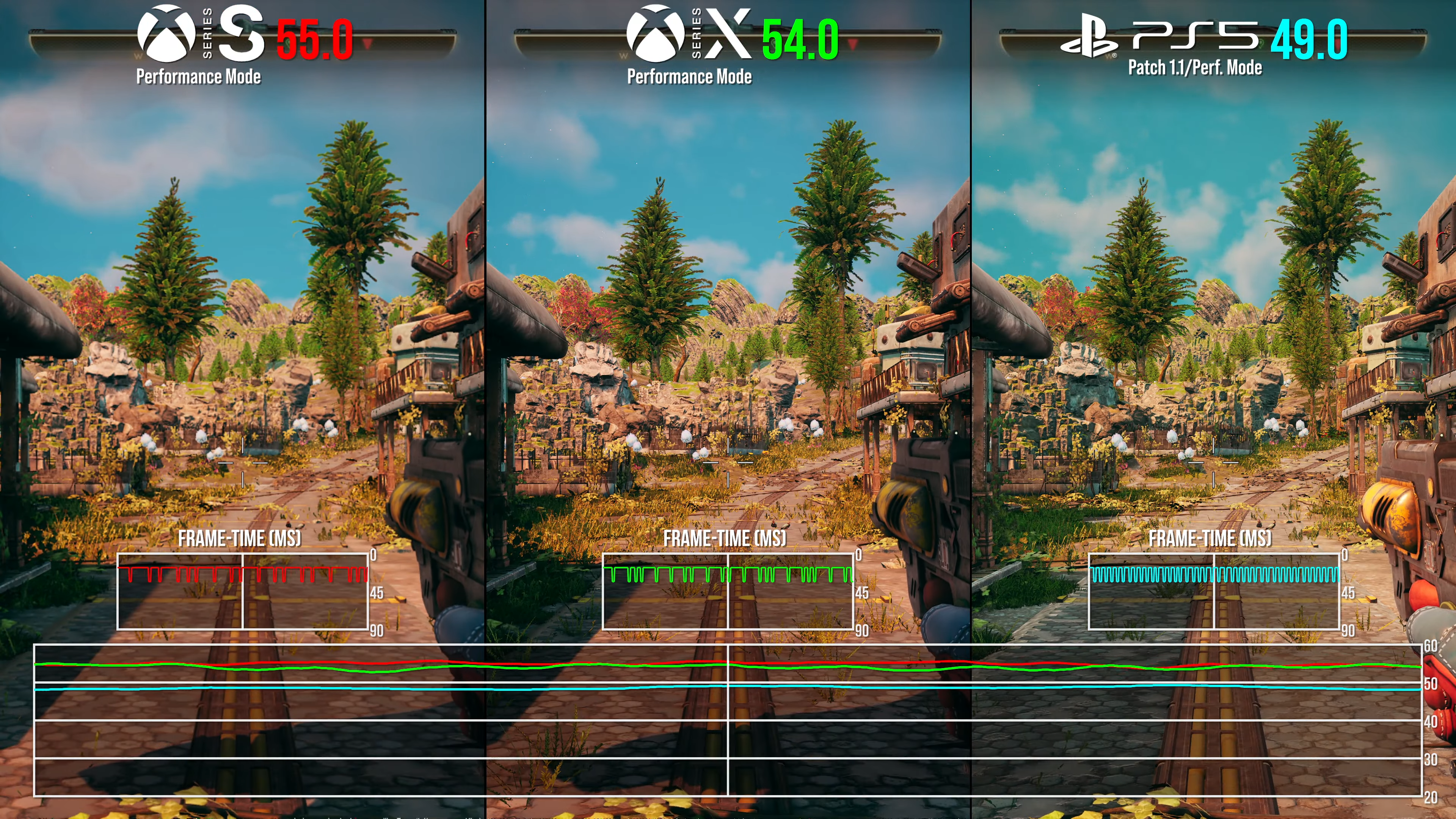
The sensible solution, on paper then, is to switch to the 60fps performance mode, but this is also far from stable. Even with patch 1.1 installed, PS5 exhibits the worst frame-rate readings, occasionally matching the Series consoles but oftentimes being a clear 8fps lower in matched tests. In one area, for example, the game ran at around 48fps on PS5 while Series S and X each hover at around 54fps. However, the Series consoles have a specific issue too: hitching blights the experience on Xbox Series X and S, with 80ms+ stutters to gameplay just as we run across the world. Surprisingly this does not affect PS5 in the same way, and it appears related to the way the Xbox machines handle terrain streaming.
No matter which console you pick, any battling outdoors is apt to take you down to the 30-40fps region, and even just under 30fps at times on PS5 – and again, this is with patch 1.1 installed on PS5. And while the Series X’s frame-rate is better on average, you’re still looking atnoticeable performance drops, under 30fps in the worst scenarios. Even VRR displays will struggle to hide such huge fluctuations between 30 and 60fps. Interior areas do at least run much better on all three machines, almost always at 60fps, but heavy bursts of alpha effects like gunfire still cause frame-rate drops. Series S exhibits low frame-rates as well, with a highly dynamic frame-rate that bounces between 30 to 60fps outdoors and mostly locks to 60fps in quieter indoor areas.
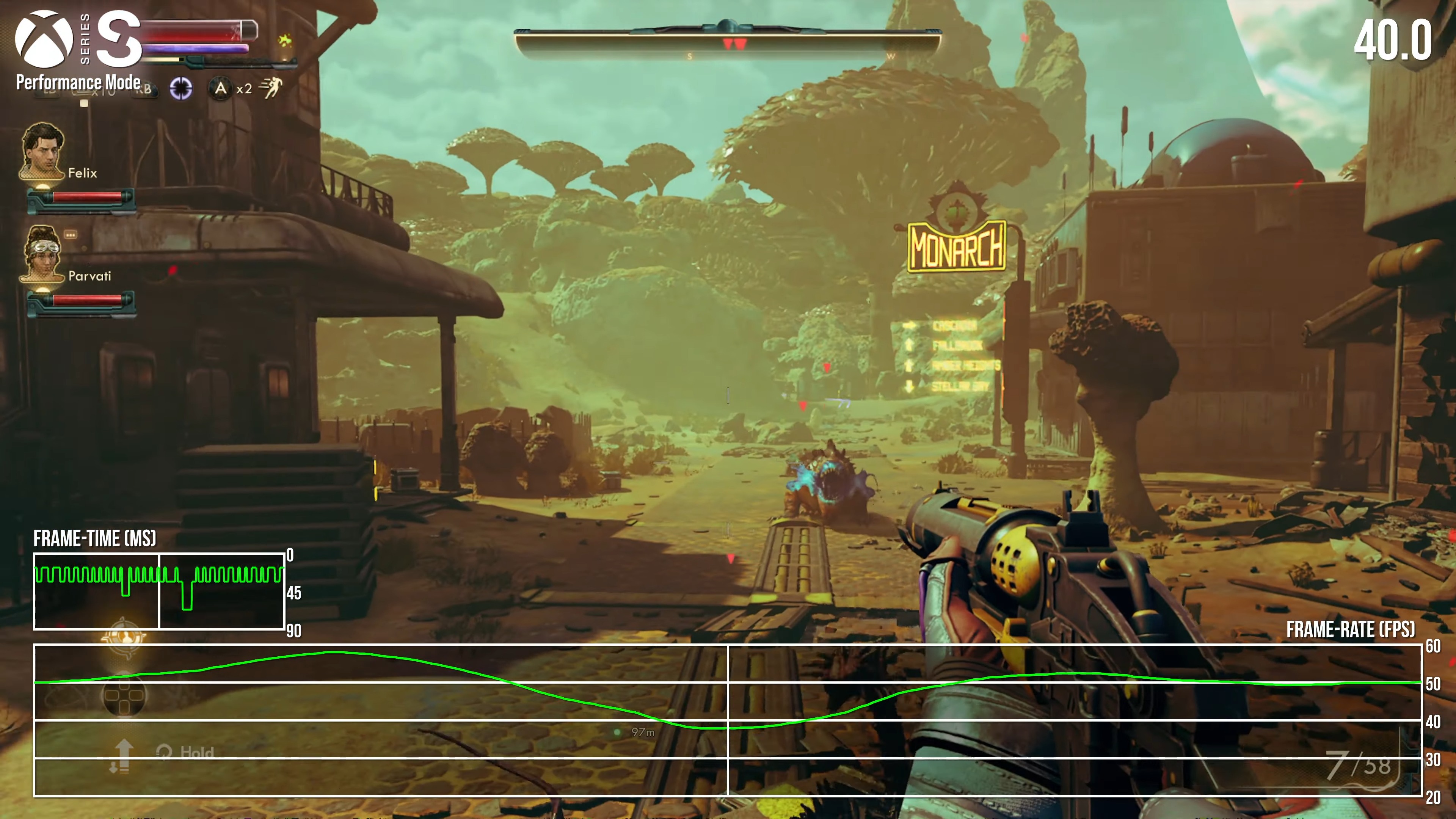
The state of performance puts a huge damper on the Spacer’s Choice Edition. Honestly, I’d much rather just go back to running the Xbox One or PS4 versions on Series X or PS5 hardware. They certainly feel much nicer to play, with a more consistent 60fps.
Further patches have been promised to fix the game’s performance problems, but despite delaying our coverage to test patch 1.1 on PS5 you’re still getting a pretty poor experience for the money. Xbox updates are due soon as well, but in fairness, Series X is already in a better place performance-wise than PS5 – not counting the hitches – and in its visual features.
As a paid upgrade, The Spacer’s Choice Edition is best avoided for now. The visual tweaks are broadly speaking well done, but they do have a knock-on effect to the art direction that might prove divisive. Less debateable are the performance issues – the frame-pacing at 30fps and the highly variable frame-rate in performance mode need to be fixed. Certainly going by the results on PS5, updates beyond patch 1.1 still have a lot to address to justify that upgrade fee. And for those that have already bought in, I seriously hope it’s possible to turn this release around soon.
www.eurogamer.net







